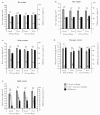Effects of larval growth condition and water availability on desiccation resistance and its physiological basis in adult Anopheles gambiae sensu stricto
- PMID: 20691104
- PMCID: PMC2922302
- DOI: 10.1186/1475-2875-9-225
Effects of larval growth condition and water availability on desiccation resistance and its physiological basis in adult Anopheles gambiae sensu stricto
Abstract
Background: Natural populations of the malaria mosquito Anopheles gambiae s.s. are exposed to large seasonal and daily fluctuations in relative humidity and temperature, which makes coping with drought a crucial aspect of their ecology.
Methods: To better understand natural variation in desiccation resistance in this species, the effects of variation in larval food availability and access to water as an adult on subsequent phenotypic quality and desiccation resistance of adult females of the Mopti chromosomal form were tested experimentally.
Results: It was found that, under normal conditions, larval food availability and adult access to water had only small direct effects on female wet mass, dry mass, and water, glycogen and body lipid contents corrected for body size. In contrast, when females subsequently faced a strong desiccation challenge, larval food availability and adult access to water had strong carry-over effects on most measured physiological and metabolic parameters, and affected female survival. Glycogen and water content were the most used physiological reserves in relative terms, but their usage significantly depended on female phenotypic quality. Adult access to water significantly influenced the use of water and body lipid reserves, which subsequently affected desiccation resistance.
Conclusions: These results demonstrate the importance of growth conditions and water availability on adult physiological status and subsequent resistance to desiccation.
Figures


References
-
- Charlwood JD, Vij R, Billingsley PF. Dry season refugia of malaria-transmitting mosquitoes in a dry savannah zone of east Africa. Am J Trop Med Hyg. 2000;62:726–732. - PubMed
-
- Powell JR, Petrarca V, Della Torre A, Caccone A, Coluzzi M. Population structure, speciation, and introgression in the Anopheles gambiae complex. Parassitologia. 1999;41:101–113. - PubMed
-
- Touré YT, Petrarca V, Traore SF, Coulibaly A, Maiga HM, Sankare O, Sow M, Di Deco MA, Coluzzi M. The distribution and inversion polymorphism of chromosomally recognized taxa of the Anopheles gambiae complex in Mali, West Africa. Parassitologia. 1998;40:477–511. - PubMed
MeSH terms
Substances
LinkOut - more resources
Full Text Sources

